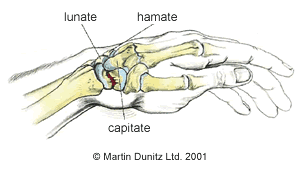| Common Signs & Symptoms | |||||
| Pain | Swelling | Stiffness | Weakness | Instability | Locking |
Broken Wrist Injury Explained
A broken wrist commonly occurs following a fall on an outstretched hand. A Scaphoid fracture is the most common fracture of the wrist region (a Colles Fracture is the other common type of wrist fracture). The Scaphoid is one of the eight small ‘Carpal’ bones that make up the wrist complex. These bones are arranged roughly into two rows and the Scaphoid lies partly in both of these rows.

The position of the Scaphoid makes it particularly susceptible to fracture. The fracture line is very small and can normally be described as hairline.
Broken Wrist Signs & Symptoms
There is a good deal of wrist pain. There is tenderness and a small area of swelling at the base of the thumb, on the outside of the wrist and the area known as the “anatomical snuffbox” is extremely tender. Moving the hand, particularly in the direction towards the thumb, will exacerbate the pain.
In the first 48 hours following injury the fracture is difficult to detect on x-ray and a cautious approach should therefore be taken. If the wrist is still painful after two weeks the wrist should be x-rayed again. At this stage the fracture is more easily visible.
Because the Scaphoid has a poor blood supply there are sometimes complications with the healing process. This may manifest itself as a diffuse ache in the wrist upon activity, and can persist for many months. This is due to a breakdown of the Scaphoid caused by the lack of blood supply and healing. If these symptoms persist for more than six weeks it is likely that the bone hasn’t healed and the patient should return to the treating doctor.
Broken Wrist Treatment
What you can do
| Consult a sports injury expert | |
| Apply cold therapy for immediate pain relief | |
| Wear a removable wrist support for protection | |
| Regain dexterity with therapeutic putty | |
| Relieve wrist stiffness with hand therapy balls | |
| Improve hand & grip strength with resistance exercises | |
| Use a bone healing system to speed up broken bone healing |
If you have fallen onto your wrist and have wrist pain, then Ice Therapy may be helpful to relieve the pain. If this wrist pain persists then you should seek medical help to have the problem assessed properly, rather than dismiss the problem as ‘a sprain’. Scaphoid fractures benefit greatly from early diagnosis and treatment, but are often underestimated by the sufferer.
In the case of a severe Scaphoid fracture where there is x-ray evidence of good alignment of the fracture fragments, the attending doctor will immobilize the wrist in a plaster. This will be worn for a period of 6 weeks to allow healing of the bone to take place. Once the cast has been removed the patient begins physiotherapy treatment to regain range of movement of the wrist joint and strength in the muscles that work over the wrist.
Rehabilitation begins immediately by maintaining the range of movement in the shoulder, elbow, fingers and thumb, on the side of the affected wrist. This prevents secondary stiffness in these areas and helps to resolve swelling in the wrist. Assuming that there are no complications with healing, the plaster can usually be removed after 6 weeks, if the doctor is satisfied that the bone has united and healed itself. At this stage more active rehabilitation can be undertaken.
Exercises in warm water are helpful to improve the hydration of the skin if it was previously encased in a plaster of paris. These also encourage the patient to gently begin moving the wrist in all directions, relieving stiffness. Exercises using Therapeutic Putty, Hand Therapy Balls and Finger & Grip Strengtheners can add strength to the muscles around the wrist and resolve wrist swelling. In the period following the removal of the plaster it may be helpful to wear a Wrist Support when not doing the exercises. On returning to normal daily activities or work a Wrist Splint may be useful to protect the wrist from too much movement and act as a deterrent from overdoing anything too soon.
If x-rays show that the Scaphoid fracture is not healing it may be necessary to treat the problem with surgery. The surgeon uses wire or a small screw to unite the two pieces of bone and may take a graft of bone from elsewhere in the body to encourage healing.
Following surgery a removable Wrist Support can provide the same degree of protection as a conventional plaster, but is much lighter and therefore more comfortable to wear. The fact that they can be removed allows washing of the wrist region, making it much more hygienic than a conventional plaster which allows the user to keep the skin in good condition. Once the treating doctor indicates that the cast is no longer required then physiotherapy treatment can help to restore hand and wrist function. Exercises using Therapeutic Putty, Hand Therapy Balls and Finger & Grip Strengtheners can add strength to the muscles around the wrist and resolve wrist swelling.
Broken Wrist Prevention
There is not a lot that can be done about a fall on an outstretched hand in most sports. However, in snowboarding the incidence of Scaphoid injury is so high that wrist guards should be worn. They significantly reduce the incidence of wrist injuries during falls a


